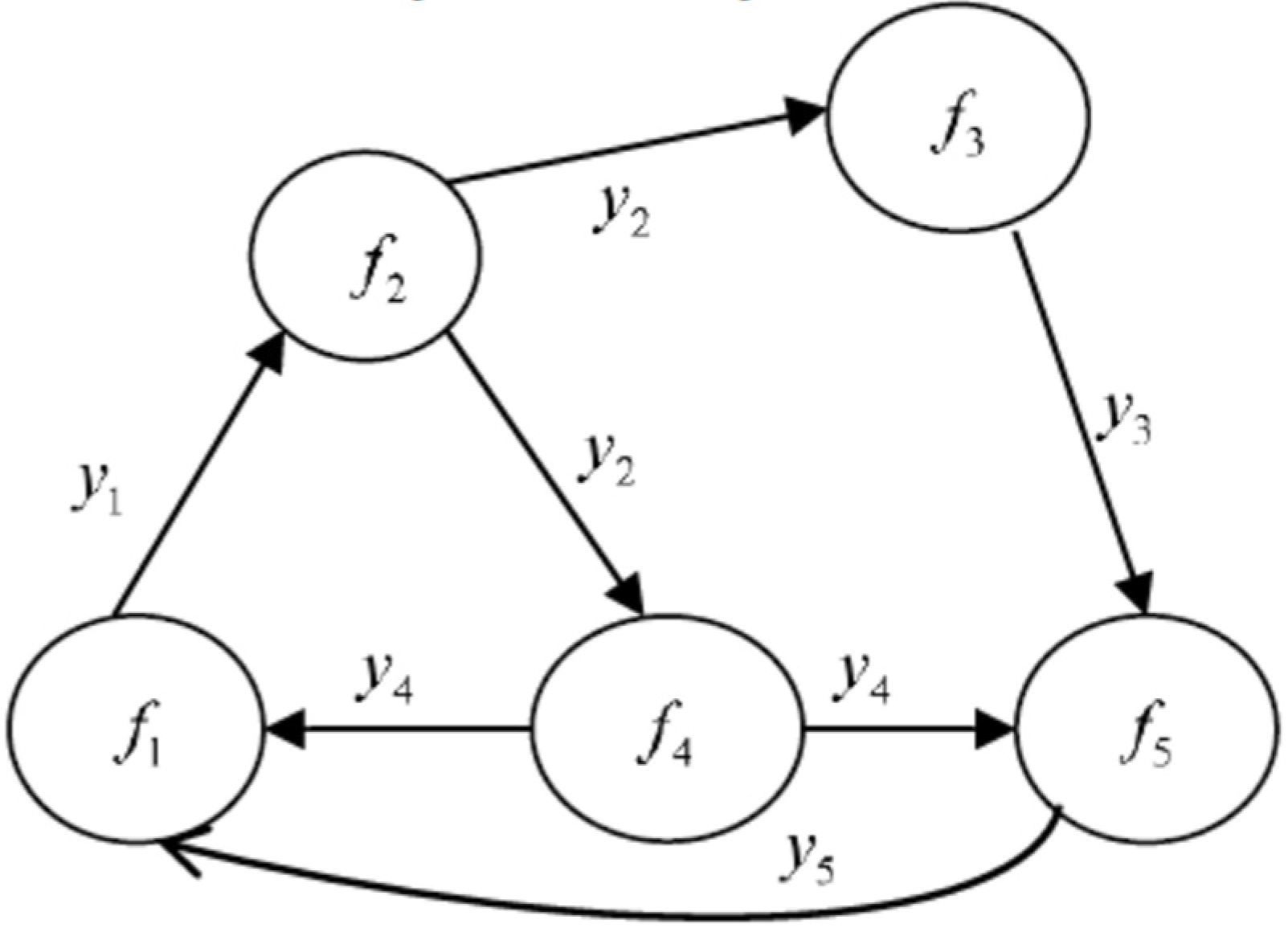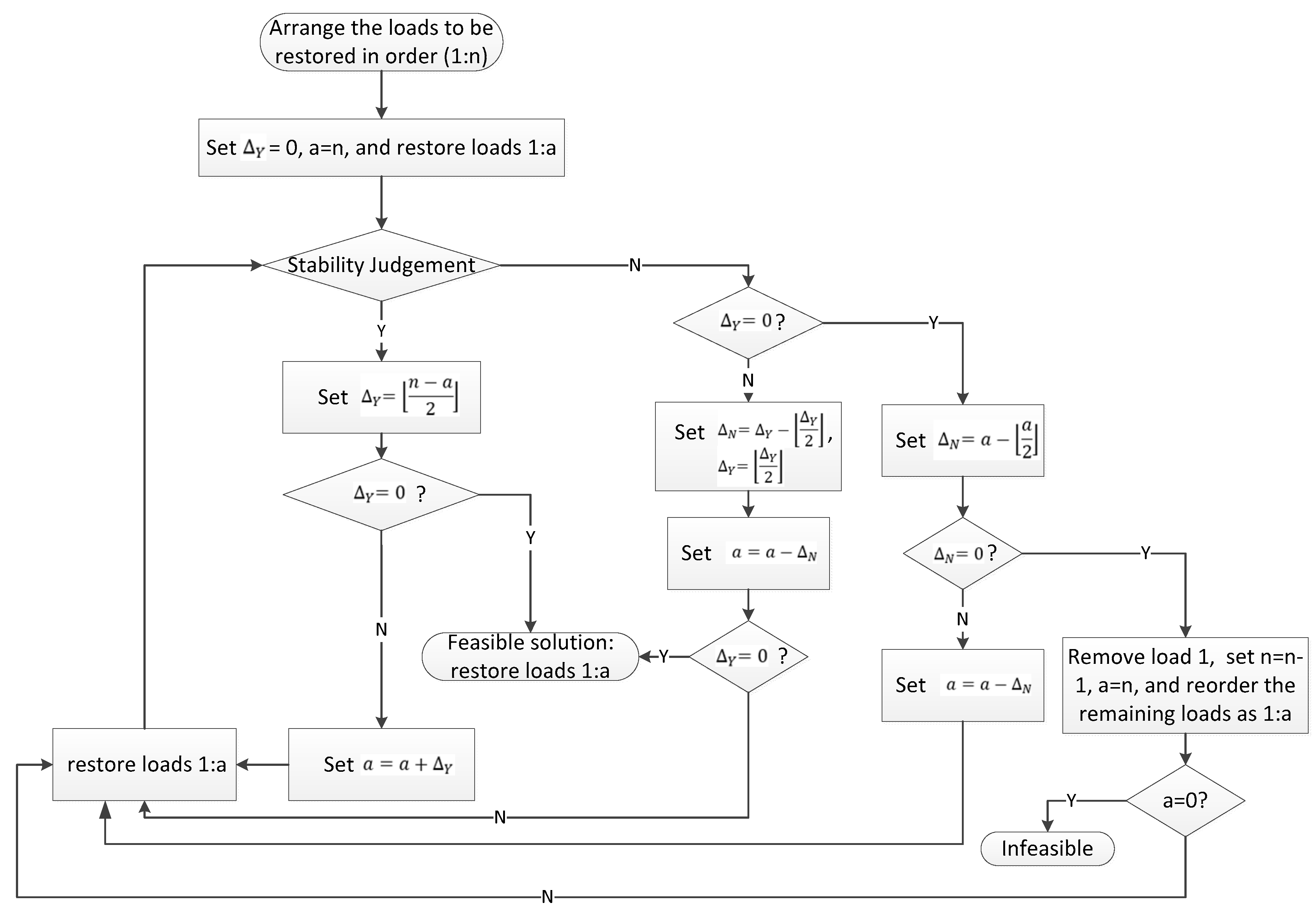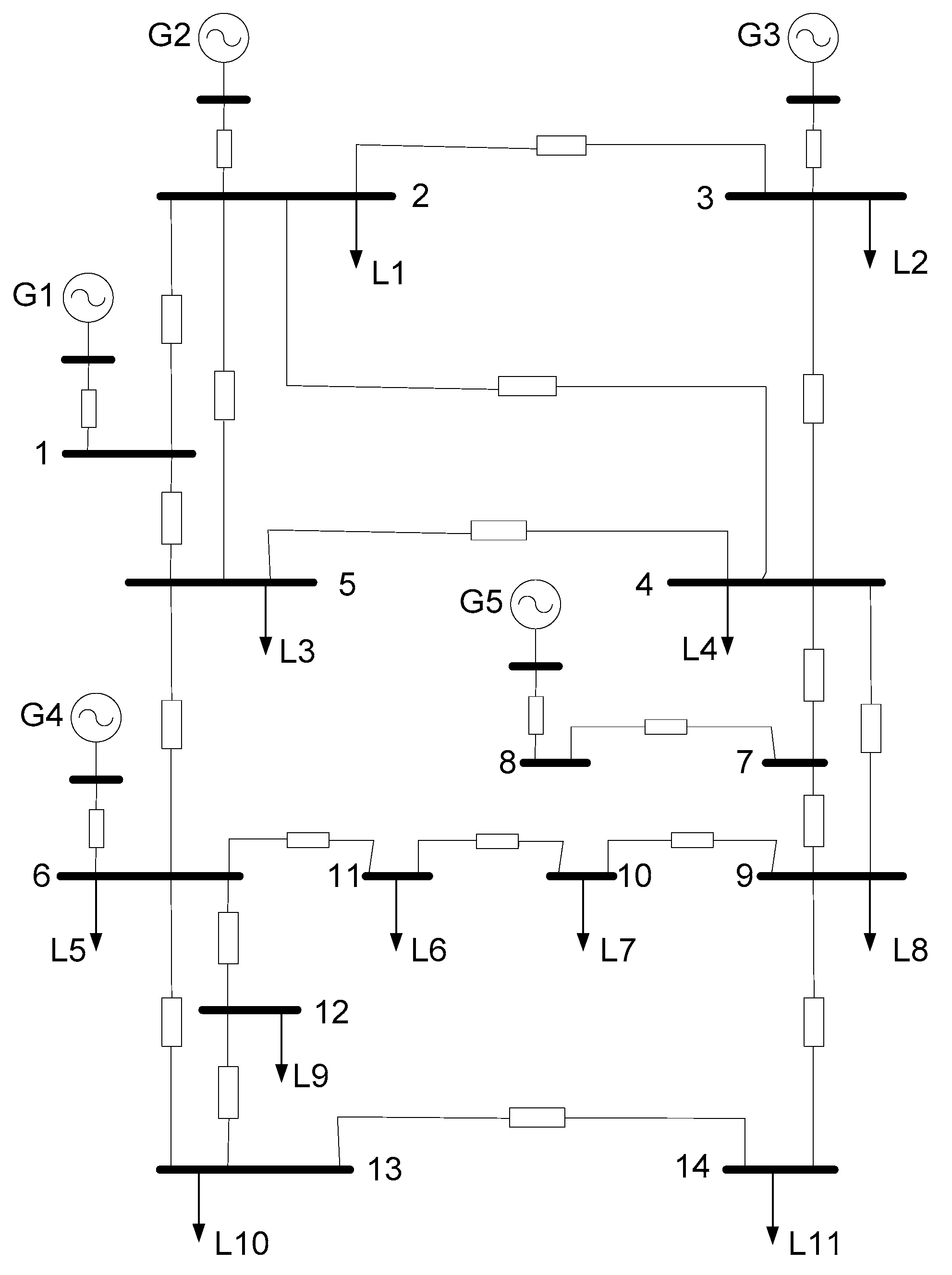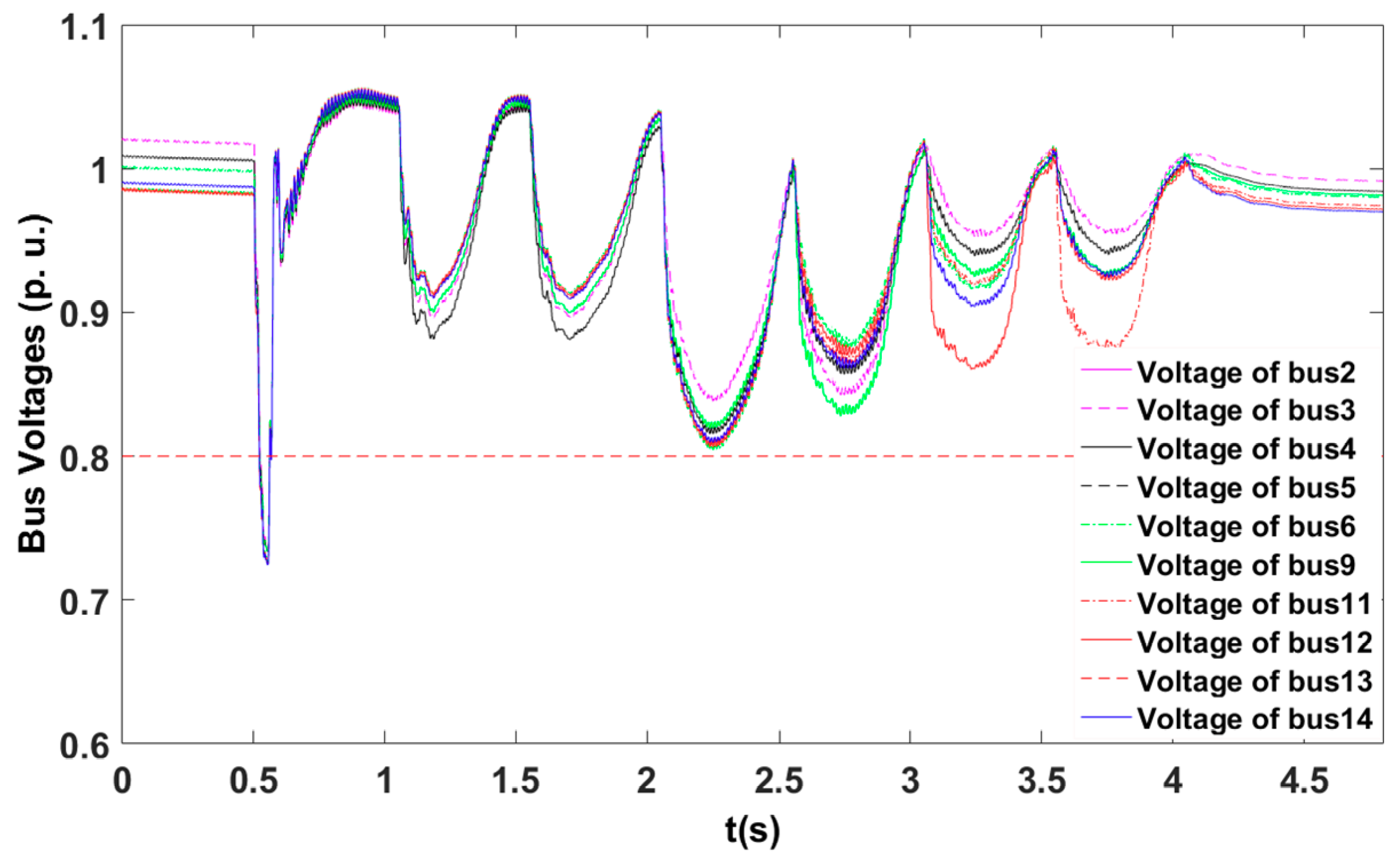An Input-to-State Stability-Based Load Restoration Approach for Isolated Power Systems
Abstract
:1. Introduction
2. Problem Formulation
3. Flexible Stability and Security Criterion
- (a)
- Small gain condition (Stability)
- (b)
- Dynamic performance conditions (Security)where , is the input to output gain matrix denoted by ; denotes the spectral radius of , , , and . For any vector , is equivalent to , and is equivalent to , . means that there exists at least one element such that . and represent the relationship between output and input, which satisfy .
4. Algorithm for Load Restoration Considering Stability and Security Constraints
4.1. Heuristic Approach
4.2. Bisection Search for the ith-Stage Restoration
5. Case Study
5.1. Load Restoration Test
5.2. Discussion
6. Conclusions and Future Work
Acknowledgments
Author Contributions
Conflicts of Interest
Appendix A. Models of the Generator and Induction Motor [11]
| Variable | Implication |
|---|---|
| d-axis synchronous reactance (p.u.) and the transient reactance (p.u.) | |
| the voltage (p.u.) behind and the generator field voltage (p.u.) | |
| the d-axis open circuit transient time constant of the generator | |
| , / | the d-axis and q-axis stator phase currents and voltages |
| , | the output (p.u.) of voltage regulator and the generator bus voltage (p.u.) |
| , | the exciter negative feedback voltage (p.u.) and reference voltage (p.u.) |
| , , , , , | the time constants and gain coefficients of the excitation system |
| saturation coefficient |
| Variable | Implication |
|---|---|
| , , , | slip (p.u.), rotor reactance, transient reactance, and stator resistance |
| , | the real part and the imaginary part (p.u.) of transient voltage |
| , | the real part and the imaginary part (p.u.) of the stator terminal voltage |
| , | the real part and the imaginary part (p.u.) of the stator current |
| , | the rotor circuit time constant and the inertia constant |
| , | the mechanical power and the output active power of the induction motor |
Appendix B. Parameters of the IPS Shown in Figure 4
References
- Concordia, C.; Fink, L.H.; Poullikkas, G. Load Shedding on an Isolated System. IEEE Trans. Power Syst. 1995, 10, 1467–1472. [Google Scholar] [CrossRef]
- Miu, K.N.; Chiang, H.D.; Yuan, B.; Darling, G. Fast service restoration for large-scale distribution systems with priority customers and constraints. IEEE Trans. Power Syst. 1997, 13, 789–795. [Google Scholar] [CrossRef]
- Ramos, E.R.; Martinez-Ramos, J.L.; Exposito, A.G.; Salado, A.J.U. Optimal Reconfiguration of Distribution Networks for Power Loss Reduction. In Proceedings of the 2001 IEEE Porto Power Tech, Porto, Portugal, 10–13 September 2001; Volume 3, p. 5. [Google Scholar]
- Morelato, A.L.; Monticelli, A.J. Heuristic search approach to distribution system restoration. IEEE Trans. Power Deliv. 1989, 4, 2235–2241. [Google Scholar] [CrossRef]
- Gao, H.; Chen, Y.; Xu, Y.; Liu, C.-C. Resilience-Oriented Critical Load Restoration Using Microgrids in Distribution Systems. IEEE Trans. Smart Grid 2016, 7, 2837–2848. [Google Scholar] [CrossRef]
- Leccese, F. Remote-Control System of High Efficiency and Intelligent Street Lighting Using a ZigBee Network of Devices and Sensors. IEEE Trans. Power Deliv. 2013, 28, 21–28. [Google Scholar] [CrossRef]
- Chen, C.S.; Lin, C.H.; Tsai, H.Y. A rule-based expert system with colored petri net models for distribution system service restoration. IEEE Trans. Power Syst. 2002, 17, 1073–1080. [Google Scholar] [CrossRef]
- Nagata, T.; Sasaki, H. An Efficient Algorithm for Distribution Network Restoration. In Proceedings of the 2001 IEEE Power Engineering Society Summer Meeting, Vancouver, BC, Canada, 15–19 July 2001; Volume 1, pp. 54–59. [Google Scholar]
- Hsiao, Y.; Chien, C. Enhancement of restoration service in distribution systems using a combination fuzzy-GA method. IEEE Trans. Power Syst. 2000, 15, 1394–1400. [Google Scholar] [CrossRef]
- Baldwin, T.L.; Lewis, S.A. Distribution load flow methods for shipboard power systems. IEEE Trans. Ind. Appl. 2004, 40, 1183–1190. [Google Scholar] [CrossRef]
- Kundur, P.; Balu, N.J.; Lauby, M.G. Power System Stability and Control; McGraw-Hill: New York, NY, USA, 1994. [Google Scholar]
- Khalil, H.K. Nonlinear Systems, 3rd ed.; Pearson Education: London, UK, 2014. [Google Scholar]
- Pai, M.A. Energy Function Analysis for Power System Stability; Kluwer Academic Press: Dordrecht, The Netherlands, 1989. [Google Scholar]
- Chiang, H.D. Direct Methods for Stability Analysis of Electric Power Systems; Wiley: New York, NY, USA, 2011. [Google Scholar]
- Chiang, H.D.; Hirsch, M.W.; Wu, F.F. Stability regions of nonlinear autonomous dynamical systems. IEEE Trans. Autom. Control 1988, 33, 16–27. [Google Scholar] [CrossRef]
- Li, F.; Chen, Y.; Qin, B.Y.; Shen, C. Decomposed input-output stability analysis and enhancement of integrated power systems. Sci. China Technol. Sci. 2018, 61, 427–437. [Google Scholar] [CrossRef]
- Sontag, E.D. Smooth stabilization implies coprime factorization. IEEE Trans. Autom. Control 1989, 34, 435–443. [Google Scholar] [CrossRef]
- Sontag, E.D.; Wang, Y. New characterizations of input to state stability. IEEE Trans. Autom. Control 1996, 41, 1283–1294. [Google Scholar] [CrossRef]
- Qin, B.; Zhang, X.; Ma, J.; Mei, S. Algorithm for Local Input to State Stability Analysis. IET Control Theory Appl. 2016, 10, 1556–1564. [Google Scholar] [CrossRef]
- Dashkovskiy, S.N.; Rüffer, B.S.; Wirth, F.R. An ISS small-gain theorem for general networks. Math. Control Signals Syst. 2007, 19, 93–122. [Google Scholar] [CrossRef]
- Qin, B.; Zhang, X.; Ma, J.; Deng, S.; Mei, S.; Hill, D.J. Input to State Stability Based Control of Doubly Fed Wind Generator. IEEE Trans. Power Syst. 2017, in press. [Google Scholar] [CrossRef]
- Liu, T.; Hill, D.J.; Jiang, Z.P. Lyapunov formulation of ISS cyclic-small-gain in continuous-time dynamical networks. Automatica 2011, 47, 2088–2093. [Google Scholar] [CrossRef]
- Liu, T.; Jiang, Z.P.; Hill, D.J. Nonlinear Control of Dynamic Networks; CRC Press: Orlando, FL, USA, 2014. [Google Scholar]
- Qin, B.; Zhang, X.; Ma, J.; Mei, S.; Hill, D.J. Local Input to State Stability Based Stability Criterion with Applications to Isolated Power Systems. IEEE Trans. Power Syst. 2016, 31, 5094–5105. [Google Scholar] [CrossRef]
- Kera, K.; Bekki, K.; Osumi, H.; Mori, K. Autonomous Successive Construction Technology without Stopping System Operation for Real-Time System. In Proceedings of the Sixth International Symposium on Autonomous Decentralized Systems, Pisa, Italy, 11 April 2003; pp. 266–273. [Google Scholar]
- Kera, K.; Bekki, K.; Mori, K.; Masumoto, I. High Assurance Step-by-Step Autonomous Construction Technique for Large Real Time System. In Proceedings of the 7th IEEE International Symposium on High Assurance Systems Engineering, Tokyo, Japan, 23–25 October 2002; pp. 79–86. [Google Scholar]
- Sontag, E.D.; Wang, Y. Notions of input to output stability. Syst. Control Lett. 1999, 38, 235–248. [Google Scholar] [CrossRef]
- Lin, Y.; Sontag, E.D.; Wang, Y. A smooth converse Lyapunov theorem for robust stability. SLAM J. Control Optim. 1996, 34, 124–160. [Google Scholar] [CrossRef]
- Masnicki, R. Validation of the Measurement Characteristics in an Instrument for Power Quality Estimation—A Case Study. Energies 2017, 10, 536. [Google Scholar] [CrossRef]
- Leccese, F.; Cagnetti, M.; Pasquale, S.D.; Giarnetti, S.; Caciotta, M. A New Power Quality Instrument Based on Raspberry-Pi. Electronics 2016, 5, 64. [Google Scholar] [CrossRef]
- China Classification Society. Rules for Construction and Classification of Sea-Going High Speed Craft; China Classification Society: Beijing, China, 2015; pp. 1–7. [Google Scholar]
- Sechilariu, M.; Locment, F.; Wang, B. Photovoltaic Electricity for Sustainable Building. Efficiency and Energy Cost Reduction for Isolated DC Microgrid. Energies 2015, 8, 7945–7967. [Google Scholar] [CrossRef]
- Iglesias, F.; Palensky, P.; Cantos, S. Demand Side Management for Stand-Alone Hybrid Power Systems Based on Load Identification. Energies 2012, 5, 4517–4532. [Google Scholar] [CrossRef]
- Gao, H.; Chen, Y.; Mei, S.; Huang, S.; Xu, Y. Resilience-Oriented Pre-Hurricane Resource Allocation in Distribution Systems Considering Electric Buses. Proc. IEEE 2017, 105, 1214–1233. [Google Scholar] [CrossRef]






| Load | |||||
|---|---|---|---|---|---|
| Nominal Power (MVA) | 0.4 | 0.3 | 0.25 | 0.2 | 0.1 |
| Level | Crucial | Vital | Vital | Important | Normal |
| Coefficient () | 4 | 2 | 2 | 1 | 0.5 |
| Generator | Asymptotic Gain | Local Region of Inputs |
|---|---|---|
| 0.058 | 2.358 | |
| 0.0633 | 2.176 | |
| 7.252 | 0.192 | |
| 5.439 | 0.194 | |
| 4.5325 | 0.195 | |
| 3.626 | 0.195 | |
| 0.4819 | 0.194 |
| Stage | Restore Load | Maximum Voltage Drop | Computational Cost | |
|---|---|---|---|---|
| Bus | Voltage Drop (p.u.) | |||
| 1 | 2 | 0.118 | 0.00872 s | |
| 2 | 5 | 0.119 | 0.00896 s | |
| 3 | , | 6 | 0.191 | 0.00711 s |
| 4 | 9 | 0.172 | 0.00948 s | |
| 5 | 12 | 0.139 | 0.00446 s | |
| 6 | , , | 11 | 0.126 | 0.00237 s |
| Stage | Restore Load | Maximum Voltage Drop | Computational Cost | |
|---|---|---|---|---|
| Bus | Voltage Drop (p.u.) | |||
| 1 | 5 | 0.158 | 0.00663 s | |
| 2 | 3 | 0.188 | 0.00892 s | |
| 3 | 12 | 0.19 | 0.00884 s | |
| 4 | 10 | 0.194 | 0.000324 s | |
© 2018 by the authors. Licensee MDPI, Basel, Switzerland. This article is an open access article distributed under the terms and conditions of the Creative Commons Attribution (CC BY) license (http://creativecommons.org/licenses/by/4.0/).
Share and Cite
Qin, B.; Gao, H.; Ma, J.; Li, W.; Zomaya, A.Y. An Input-to-State Stability-Based Load Restoration Approach for Isolated Power Systems. Energies 2018, 11, 597. https://doi.org/10.3390/en11030597
Qin B, Gao H, Ma J, Li W, Zomaya AY. An Input-to-State Stability-Based Load Restoration Approach for Isolated Power Systems. Energies. 2018; 11(3):597. https://doi.org/10.3390/en11030597
Chicago/Turabian StyleQin, Boyu, Haixiang Gao, Jin Ma, Wei Li, and Albert Y. Zomaya. 2018. "An Input-to-State Stability-Based Load Restoration Approach for Isolated Power Systems" Energies 11, no. 3: 597. https://doi.org/10.3390/en11030597





